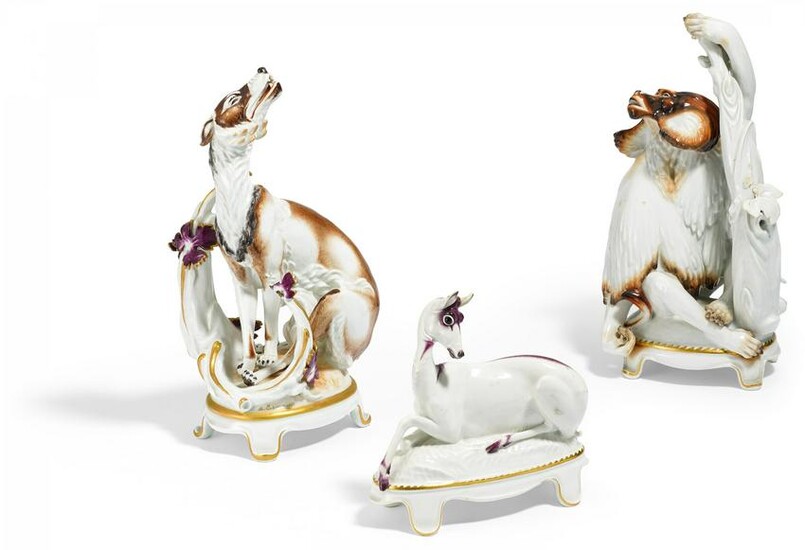Baboon, wolf and roebuck from centrepiece Reinecke
PORCELAIN FIGURINES OF THE BABOON, WOLF AND ROEBUCK FROM THE CENTREPIECE "REINECKE FUCHS".
Meissen.
Date: Once 1925-1934, twice after 1934.
Maker/Designer: Models M. Esser 1922 and 1923.
Technique: Porcelain, sparingly enriched in colours and gold.
Description: All three animals sit on oval, footed pedestals in poses typical for their species. The
baboon reaches for the top of a stylized tree that sticks up besides him. His right hand
is curled up in a manner typical for apes. The howling wolf is also sitting in a stylized
thicket. His gaunt body describes a curve that continues in the twist of his neck into his
highly raised snout. The dainty roebuck lies on his pedestal, eyes wide-awake, ears
pointed. The left foreleg is set up as if the animal is prepared to jump up at any moment.
Measurement: Height 27cm/27,5cm/15cm.
Mark: Once Pfeiffer mark, twice swords mark, pressed swords with fox, H246/H243/H250, porcelain former no. 128/131/23, painter's no. 71/69/71.
Mark: All inscribed on the base 'M. Esser' in gold, wolf with addition 1922 and additional inscription 'M. Esser' carved into the base.
Condition C.
Provenance:
Private collection Hesse.
Literature:
- Marusch-Krohn, Caren: Meissener Porzellan 1918-1933. Die Pfeifferzeit, Leipzig 1993, regarding the centrepiece see p.105-108.
- Jedding, Hermann. Meißener Porzellan des 19. und 20. Jahrhunderts 1800-1933, Munich
1981, comp. p.123.
Max Esser's (1885-1945) special talent was to summarize and express essential characteristics of an animal in one distinctive gesture or pose. He achieved a perfect balance between stylization and astonishing liveliness, making use of the contrast between smooth surfaces and sharp lines.
He was one of the most important freelance artists who worked for the Meissen manufactory during the Pfeiffer period. His centrepiece is a complete work comprising 75 parts. Esser takes up the 18th century tradition of narrative centrepieces and chooses Goethe's epic ''Reineke Fuchs'' as his literary model. Consisting of flower and fruit bowls, candlesticks and above all animal sculptures, the essay shows the gathering of animals at court..
Condition Report: Estimated shipping costs for this lot:
Shipping only by arrangement after the auction.
View it on
Sale price
Estimate
Time, Location
Auction House
PORCELAIN FIGURINES OF THE BABOON, WOLF AND ROEBUCK FROM THE CENTREPIECE "REINECKE FUCHS".
Meissen.
Date: Once 1925-1934, twice after 1934.
Maker/Designer: Models M. Esser 1922 and 1923.
Technique: Porcelain, sparingly enriched in colours and gold.
Description: All three animals sit on oval, footed pedestals in poses typical for their species. The
baboon reaches for the top of a stylized tree that sticks up besides him. His right hand
is curled up in a manner typical for apes. The howling wolf is also sitting in a stylized
thicket. His gaunt body describes a curve that continues in the twist of his neck into his
highly raised snout. The dainty roebuck lies on his pedestal, eyes wide-awake, ears
pointed. The left foreleg is set up as if the animal is prepared to jump up at any moment.
Measurement: Height 27cm/27,5cm/15cm.
Mark: Once Pfeiffer mark, twice swords mark, pressed swords with fox, H246/H243/H250, porcelain former no. 128/131/23, painter's no. 71/69/71.
Mark: All inscribed on the base 'M. Esser' in gold, wolf with addition 1922 and additional inscription 'M. Esser' carved into the base.
Condition C.
Provenance:
Private collection Hesse.
Literature:
- Marusch-Krohn, Caren: Meissener Porzellan 1918-1933. Die Pfeifferzeit, Leipzig 1993, regarding the centrepiece see p.105-108.
- Jedding, Hermann. Meißener Porzellan des 19. und 20. Jahrhunderts 1800-1933, Munich
1981, comp. p.123.
Max Esser's (1885-1945) special talent was to summarize and express essential characteristics of an animal in one distinctive gesture or pose. He achieved a perfect balance between stylization and astonishing liveliness, making use of the contrast between smooth surfaces and sharp lines.
He was one of the most important freelance artists who worked for the Meissen manufactory during the Pfeiffer period. His centrepiece is a complete work comprising 75 parts. Esser takes up the 18th century tradition of narrative centrepieces and chooses Goethe's epic ''Reineke Fuchs'' as his literary model. Consisting of flower and fruit bowls, candlesticks and above all animal sculptures, the essay shows the gathering of animals at court..
Condition Report: Estimated shipping costs for this lot:
Shipping only by arrangement after the auction.



